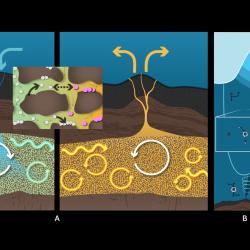Geology Associate Professor Karen Prestegaard Answers Questions About Hydrology
The College of Computer, Mathematical, and Natural Sciences hosted a Reddit Ask-Me-Anything spotlighting research on stormwater management and flooding.

University of Maryland Geology Associate Professor Karen Prestegaard participated in an Ask-Me-Anything (AMA) user-led discussion on Reddit to answer questions about drinking water issues and flooding on September 29, 2025.
Prestegaard’s lab is studying changes in precipitation, including its distribution over time and the effects that precipitation clustering and increased intensity have on runoff, groundwater recharge and floods. They also examine the impacts of streamflow changes on sediment and solute loads from river basins.
In her work with the Climate Resilience Network, Prestegaard leads a team that is researching the links between precipitation, stream baseflow, stormwater runoff and evapotranspiration in forested, agricultural and urban catchments in Maryland and the mid-Atlantic region.
This Reddit AMA has been edited for length and clarity.
In Mid Wales, where I live, the runoff issues are mainly from 19th-century lead mine spoil tips inland. What practical steps can be taken to reduce the risk of toxins entering our waterways?
Intense storm events can erode particles and transport them to streams, which might increase particulate lead in streams. Lead can be dissolved in water under acidic and/or reducing conditions. Therefore, acidic or long-duration storm events may lead to the mobilization of lead in solution, which can travel with the water to streams.
A step that has been taken to limit lead mobilization is the work that's been done in the past 50 years to decrease acid rain, primarily from coal-fired power plants, which has been incredibly effective. However, lead ores often are found with pyrite and other sulfide minerals. When these oxidize, sulfuric acid is produced, which can mobilize lead in solution. Therefore, the characteristics of the lead tailings are very important.
Another common remediation effort to keep lead from being mobilized in solution is to buffer the pH with crushed limestone or other carbonates. There are many other approaches to remediation, including keeping the tailing piles as dry as possible by diverting water from the sites.
When I keep the tap running, won't that water eventually be going back into circulation? So how is it then wasted?
The water that comes out of your tap has been treated before it gets to you, and has to be treated again before it is returned to the rivers. Therefore, this is expensive water, even if you pay very little for it. If you live near the headwaters of a river, the water you use can be treated, returned and used again downstream. However, most major cities are coastal or in the downstream portions of major rivers. During dry periods, the water supply may be limited. Most people who live in headwater regions are in rural areas where streams are not big enough to supply water. Their water supplies are derived from groundwater. Groundwater is water in storage; it's more expensive to retrieve, and it can be used faster than it is replenished.
How clear is the data on the rise in storms?
We are just beginning to obtain the data that we need on changes in storm duration, intensity and frequency. In Maryland, we are observing significant increases in the intensity of short-duration (5-minute to 3-hour) storm events. These storms create flash floods in small streams and in urban areas.
In a watershed that I monitor, we had six 30-minute storms that exceeded the NOAA 100-year storm in the past year. A 100-year storm has a 1 in 100 probability of occurrence in a single year, and we had six of these events in one year. Other parts of the country and the world are seeing increases in long-duration events, such as hurricanes, tropical storms and winter storms.
Does your field need more data scientists?
Yes! Many of my students are essentially data scientists, but they all go out in the field too. In Maryland, due to the increase in short-duration storm intensity, we need more rainfall data and more information on the response of small streams. Therefore, we need both more monitoring and more data scientists to analyze this data.
Have you tracked coliform levels in water in reference to year-to-year water levels? Are there more issues when the weather is warmer? Also, have you noticed any increase or decrease in the flora and fauna due to heat/flooding/drought/cold?
I have not been tracking coliform bacteria levels. However, locally, the USGS has been doing this on the Anacostia and other rivers. They are finding that the big storm events increase coliform bacteria. But during periods without major storms, the Anacostia has low enough coliform bacteria levels to be almost swimmable.
The decrease in snowpack is a significant problem in the U.S. Northeast and mountain states, where snowmelt determines the characteristics of the annual streamflow hydrograph. There is a lot of evidence that this is leading to changes in stream biota. We also see major decreases in low flow levels in the southeastern U.S., places that do not normally have significant snowmelt runoff. This decrease in low flow levels appears to be related to gaps in precipitation and hot, dry conditions, along with increasing urbanization.
I’ve been reading about how forever chemicals are showing up in different water sources. From your perspective, is it more realistic to focus on keeping these out of drinking water in the first place, or on improving treatment methods to filter them out once they’re already there?
For the forever chemicals, it's important to keep them out in the first place. But that can include stopping them along the delivery pathways. Groundwater contamination by some of these compounds can be remediated as the water moves toward streams. In general, remediation is expensive and difficult. Remediation can be conducted at the intake of water supply systems, which is useful for drinking water, but it doesn't address the contamination of streams that impacts aquatic organisms.
What are some steps cities can take to prevent the kind of flooding we see after hurricanes? Is this just something we have to live with, or are there options?
Hurricanes are becoming larger due to increases in air and ocean water temperatures. Therefore, we are seeing hurricanes that cover large spatial areas and produce intense storms, often at significant distances from the coast (e.g., Asheville, NC, and Houston, TX). Coastal cities and inland cities were not built with these types of storms in mind. We are already seeing people with wealth moving inland from the coast in South Florida, increasing the cost of housing in those areas. The combination of sea-level rise and increases in rainfall amounts and intensity makes it difficult to engineer water removal systems. Therefore, adaptation for living in coastal areas where hurricanes are expected needs to include building structures that can survive both flooding and wind damage. An example is this community in Cortez, Florida, that was built to withstand hurricane winds and flooding.
However, the landscape also needs to adapt. In some places, hurricanes moved multiple feet of sand onshore, raising the elevation of the land. Often, these deposits are removed because they bury structures. The movement of sand that is building up barrier islands and coastal areas is a natural adaptation method that we need to be able to work with.
How are toilet cleaners and other common household chemicals handled from a water treatment and quality point of view?
Minimizing the chemicals that you use in the home and put down your drains is always a good idea. I use baking soda to clean my toilet.
We have a stream in our garden, and we wondered if the water is OK for kids to play in, to water plants we'll later eat, or even to drink. We're on the side of a hill in a semi-built-up area in the middle of two public parks, and I'm fairly sure it runs through a nearby golf club upstream.
It sounds like this stream receives runoff from urban areas during storms and from groundwater draining forested regions and the golf club. I would have your kids avoid playing in the stream immediately after storms. Also, skin is a very good protectant. Just make sure your kids don't have any open wounds when they play in the stream. You can test for coliform bacteria if you are concerned.
Have climate change and changes to the frequency of flooding shifted the erosional/depositional nature of some river valleys? Have depositional valleys begun eroding more frequently, or vice versa? Or maybe these processes are just being amplified by the greater frequency of floods?
Yes. One of the things we have noticed in the mid-Atlantic is a large increase in the intensity of summer storms. In the 1970s and '80s, winter storms often generated the largest sediment loads in streams due to freeze-thaw activity and agricultural practices. We are now seeing the largest sediment loads in this region being carried by summer storms. Much of the sediment supply is from eroding stream banks. In urban areas, sediment is also supplied from construction sites, which are much more active in the summer months. The decrease in freeze-thaw activity and improvement in agricultural practices have decreased sediment sources in winter periods in many regions.
Has there ever been any attempt to use beavers to increase wetlands for human benefit?
Yes! This is a very active area of stream restoration in many parts of the western United States. Bringing back beavers is increasing water storage in many western watersheds. The beaver activity is also increasing naturally in the eastern U.S., but in some cases, it creates conflicts with landowners who don't want the flooding or tree damage.
The weather in Maryland has been kind of weird this past year, where we're almost getting monsoon seasons and then drought seasons. Has this been predicted with climate models as a new weather pattern for the area? We've already seen some horrendous flash flooding in Western Maryland this year. Is the flash flooding anticipated to increase?
Precipitation variability has been predicted in climate models. We have been tracking "climate whiplash," rapid changes from intense storms to periods without rainfall. My students and I have been developing techniques to characterize these changes in the timing of precipitation events. In some places in Maryland, gaps between precipitation events are getting longer, and storm events are getting more intense, but the annual precipitation is staying about the same.
These new weather patterns are leading to both lower stream baseflow and higher storm runoff peaks, particularly in smaller watersheds. Although flash flooding is increasing with increases in storm intensity, predicting where flash floods are going to occur is difficult. This is one of the reasons why UMD has installed the Maryland Mesonet and Hydronet, and why I am monitoring many small streams.
What can I do in my local area to improve/ reduce flash flooding effects?
Flash flooding in urban areas has become more dangerous due to the increase in the intensity of the storms. Reporting roadways that flood during moderate storms is an important step that community members can perform to help identify sites that would be problematic during more intense storms. Improving stormwater retention in your community, including in your yard through the use of rain gardens, rain barrels, etc., and advocating for green space would also help. Lawns with short grass usually have lower infiltration capacity than meadows or native plants that grow to larger heights and add organic matter to the soil.







